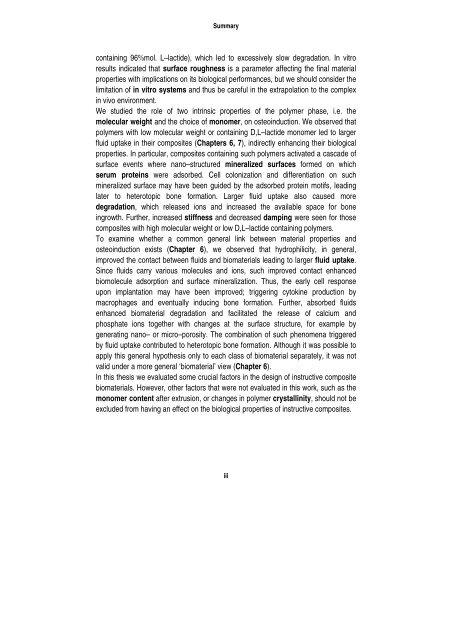Barbieri Thesis - BioMedical Materials program (BMM)
Barbieri Thesis - BioMedical Materials program (BMM)
Barbieri Thesis - BioMedical Materials program (BMM)
Create successful ePaper yourself
Turn your PDF publications into a flip-book with our unique Google optimized e-Paper software.
Summary<br />
containing 96%mol. L–lactide), which led to excessively slow degradation. In vitro<br />
results indicated that surface roughness is a parameter affecting the final material<br />
properties with implications on its biological performances, but we should consider the<br />
limitation of in vitro systems and thus be careful in the extrapolation to the complex<br />
in vivo environment.<br />
We studied the role of two intrinsic properties of the polymer phase, i.e. the<br />
molecular weight and the choice of monomer, on osteoinduction. We observed that<br />
polymers with low molecular weight or containing D,L–lactide monomer led to larger<br />
fluid uptake in their composites (Chapters 6, 7), indirectly enhancing their biological<br />
properties. In particular, composites containing such polymers activated a cascade of<br />
surface events where nano–structured mineralized surfaces formed on which<br />
serum proteins were adsorbed. Cell colonization and differentiation on such<br />
mineralized surface may have been guided by the adsorbed protein motifs, leading<br />
later to heterotopic bone formation. Larger fluid uptake also caused more<br />
degradation, which released ions and increased the available space for bone<br />
ingrowth. Further, increased stiffness and decreased damping were seen for those<br />
composites with high molecular weight or low D,L–lactide containing polymers.<br />
To examine whether a common general link between material properties and<br />
osteoinduction exists (Chapter 6), we observed that hydrophilicity, in general,<br />
improved the contact between fluids and biomaterials leading to larger fluid uptake.<br />
Since fluids carry various molecules and ions, such improved contact enhanced<br />
biomolecule adsorption and surface mineralization. Thus, the early cell response<br />
upon implantation may have been improved; triggering cytokine production by<br />
macrophages and eventually inducing bone formation. Further, absorbed fluids<br />
enhanced biomaterial degradation and facilitated the release of calcium and<br />
phosphate ions together with changes at the surface structure, for example by<br />
generating nano– or micro–porosity. The combination of such phenomena triggered<br />
by fluid uptake contributed to heterotopic bone formation. Although it was possible to<br />
apply this general hypothesis only to each class of biomaterial separately, it was not<br />
valid under a more general ‘biomaterial’ view (Chapter 6).<br />
In this thesis we evaluated some crucial factors in the design of instructive composite<br />
biomaterials. However, other factors that were not evaluated in this work, such as the<br />
monomer content after extrusion, or changes in polymer crystallinity, should not be<br />
excluded from having an effect on the biological properties of instructive composites.<br />
iii





